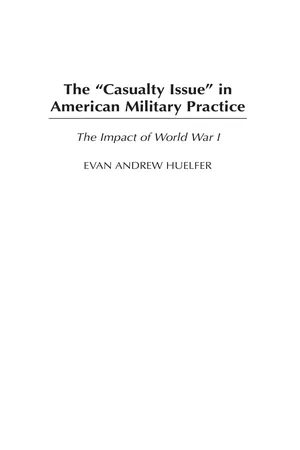
The Casualty Issue in American Military Practice
The Impact of World War I
- 264 pages
- English
- PDF
- Available on iOS & Android
About this book
Huelfer examines the casualty issue in American military thought and practice during the years between the World Wars. He argues that Americans exhibited a distinct aversion to combat casualties duirng the Interwar Period, a phenomenon that visibly influenced the military establishment and helped shape strategic planning, force modernization, and rearmament for World War II. In a broad topical approach, Huelfer's main theme—casualty aversion—is woven into discussions about military strategy and policies, doctrinal and technological development, the military education system, and how the American officer corps emerged from World War I and prepared for World War II. As Huelfer makes clear, aversion to combat casualties is not just a post-Vietnam War phenomenon, but rather has long been embedded within the American national heritage. Conventional wisdom link today's exacerbated aversion to combat casualties as fallout from the Vietnam debacle. In fact, this Vietnam Syndrome has remained at the forefront of contemporary strategic thinking. Huelfer shows that American political and military leaders have held lasting concerns about risking soldiers' lives in combat, even pre-dating U.S. involvement in World War II. The grim experiences of World War I had a profound impact upon the U.S. officer corps and how it viewed potential future conflicts. The casualty issue permeated the officers' strategic culture during the Interwar Period and colored their thinking about improving training, doctrinal evolution, force modernization, and technological development. Even though one cannot find the terms casualty issue, casualty aversion, or sensitivity to casualties directly stated in the speeches and writings of the era, this awareness clearly emerged as a subtext for the entire American effort in preparation for World War II. Huelfer highlights how casualty aversion shaped American strategy for World War II by incorporating ideas about the use of overwhelming force, air power, and mechanization—all designed to minimize losses.
Frequently asked questions
- Essential is ideal for learners and professionals who enjoy exploring a wide range of subjects. Access the Essential Library with 800,000+ trusted titles and best-sellers across business, personal growth, and the humanities. Includes unlimited reading time and Standard Read Aloud voice.
- Complete: Perfect for advanced learners and researchers needing full, unrestricted access. Unlock 1.4M+ books across hundreds of subjects, including academic and specialized titles. The Complete Plan also includes advanced features like Premium Read Aloud and Research Assistant.
Please note we cannot support devices running on iOS 13 and Android 7 or earlier. Learn more about using the app.
Information
Table of contents
- Preface
- Introduction
- Abbreviations
- 1 The Experience of the Great War
- 2 The Dark Shadow of the Great War
- 3 Drawing Immediate Lessons from Combat
- 4 Revamping the Military Education System
- 5 The Application of American Power
- 6 Strategic Planning in the Interwar Period
- 7 Preparing for War, 1939–1941
- Conclusion
- Select Bibliography
- Index